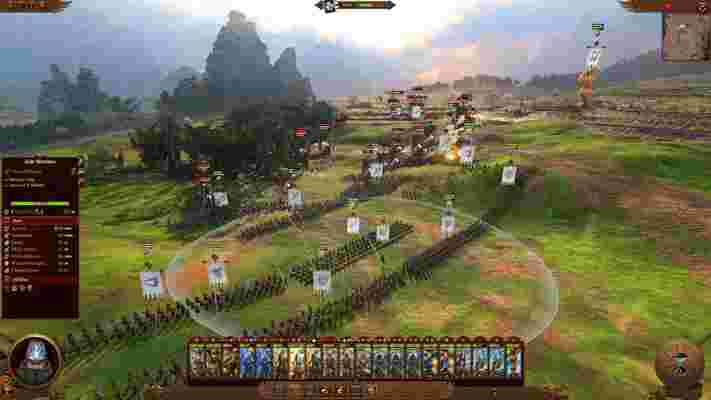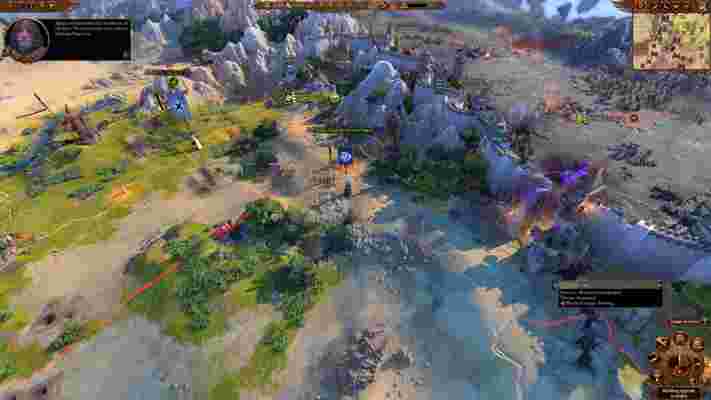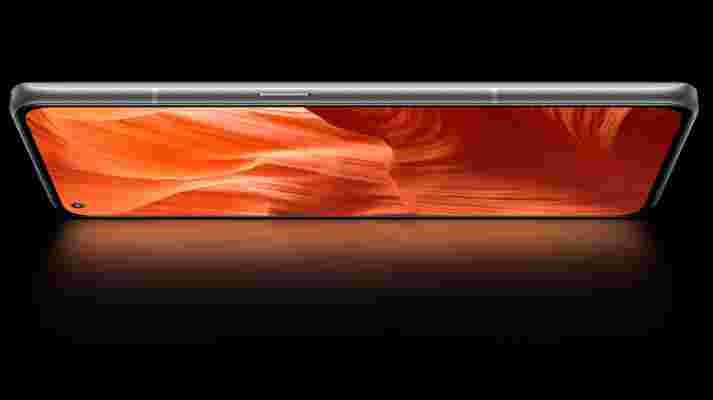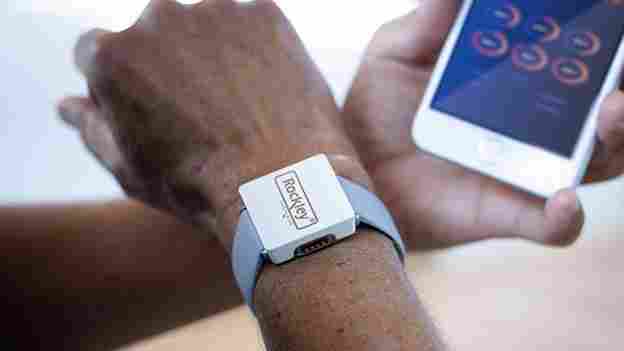Warhammer Fantasy has always excelled at the catastrophic. Its grimdark world isn’t just full of heinous monstrosities, they’re practically baked into its bedrock. It’s a setting that forever hangs on the edge, as unceasing legions of bloodthirsty daemons, feculent spawn, and debaucherous sadists threaten all mortal life. Total War: Warhammer 3 looks to lose none of that dark grandiosity. In fact, the game dials it up even further.
Playing an eight-hour, hands-on preview of the game’s new Cathay and Daemons of Chaos faction, it quickly becomes clear that Creative Assembly has set its sights higher for the third installment of the series. The familiar sandbox system for which Total War has become renowned remains intact, but it’s overshadowed by a greater emphasis on framed, focused campaigning. There’s a narrative edge this time around, and one from which you can’t escape.
Daemon spawn

I begin by trying my hand at the Daemons of Chaos. A potpourri of evil, this lot amalgamates every Chaos faction into one big hodgepodge of daemonic blight. While the forces of the four Chaos gods – Nurgle, Khorne, Slaanesh, and Tzeentch – are usually played separately in the campaign, this faction hands you all of them, letting you march crimson Bloodletters alongside pestilent Nurglings. It leans into one of the best parts of the Total War: Warhammer series – its color, its bombast, and the sheer silliness that isn’t seen in the series’ historical titles.
This new faction is also one of the most varied. FIlling out your armies with whatever units take your fancy allows for a level of customization that hasn’t been seen in any previous Total War game. At one end of your empire, you might be fielding a force predominantly made up of Tzeentch’s Horrors, Flamers, and other mutated creatures. But a few settlements away, another army of yours can be full of Beasts of Nurgle and Khorne Flesh Hounds. I found half the fun was building Chaotic combinations to field in battle, seeing which paired well together, and which made for the strangest result.
This customization is the name of the game when it comes to the Daemons of Chaos. Fronting your legions is your very own Daemon Prince, a scion of the Ruinous Powers that can be outfitted with weapons, armor, and even body parts of your choosing. As you conquer settlements and complete missions on the campaign map, you’ll earn favor with the four Chaos gods, choosing which to devote your affection towards. Earn enough favor, and you’ll not only unlock new units of that god’s roster to add to your armies, but also new heads, arms, and tails with which to mutate your Daemon prince for passive buffs and cooldown abilities. They make for big changes, majorly affecting how your Lord plays in battle as well as how they look.
Warhammer’s always been an excuse to play dress-up and the daemonic bodybuilding gimmick here goes some way to imitating the tabletop game’s model building. But I quickly became overloaded with choice. You unlock new accoutrements at such a rate that it feels like a slog to sift through every option. In my playthrough, I felt better throwing my hands up in surrender, before picking an outfit that had aesthetic nous rather than any tactical thought behind it.
Cathay’s coming

On the other side of the map lies Cathay, a faction that’s almost as new to Total War as it is to the Warhammer franchise. Besides some fleeting mentions in the Warhammer lore, Cathay never received a rulebook or miniatures and has become one of those notorious ‘what could have been’ factions among players. Creative Assembly’s interpretation is really the first official implementation of the faction to date.
And it’s a good one. Building on all the usual tropes of Chinese mythology, Cathay won’t win any fantasy awards for originality, but it does stand out as unique in the world of Warhammer. The only other human faction in the game besides Kislev, it’s halfway between an ordinary medieval army and a dunk in a wild storybook. Infantry march alongside armored gunners, while huge Terracotta Sentinels tower above. Flying war machines rain cannonballs and fire from above, and, to fit the Chinese theme, its Lords can transform into serpentine dragons.
On the campaign map, Cathay will be familiar to those who’ve delved deep into other Total War games. While the Daemons of Chaos are encouraged to constantly wage war in every direction, Cathay’s position on the map calls for more strategic conquering. At the start of the preview, the forces of Tzeentch were hammering away at the vital wall separating my mortal lands from the Chaos wastes beyond, while rebels were decimating my settlements from within. I needed to shore up support at home – either diplomatically or through force – while keeping the tide of Chaos at bay.
Other mechanics add variety. Every aspect of Cathay’s development, including building construction and progress along its rather linear tech tree, is governed by ‘harmony,' and every action you take on the campaign map will push its harmony meter towards either ‘Yin’ or ‘Yang.’ The trick is to strike a balance. At times, it will work out splendidly, as you find harmony has righted itself, granting all your units vital buffs for an upcoming battle. At other times, you might be pushed into a course of action you’d have rather avoided – maybe spare an enemy settlement – as you desperately try to keep harmony in balance to avoid suffering its penalties.
Framed and focused

If it sounds like Cathay provides less of the sandbox strategy experience that many Total War fans are used to, that’s no coincidence. Total War: Warhammer 3 is far more framed than its predecessors. It focuses on a central campaign that can be played in any way, but pushes you towards a single objective regardless of which faction you pick.
While you’re conquering the mortal world, rifts to the Realm of Chaos will periodically appear across the map. They act as gateways to previously inaccessible, discrete areas themed around the Chaos gods. Send your armies through, and fight whatever marauding warbands lie waiting on the other side, before eventually making your way to a final stronghold and duking it out with a Chaos champion. Do that four times (one for each Chaos god), and you’ll unlock the campaign’s endgame.
These rifts function something like dungeons in classic RPGs. They’re short, self-contained, and totally cut off from the rest of the game. In my time with the preview, they appeared on the map around turn 35, after which point every faction dropped their previous goals and descended onto the gateways in force. They not only punctuate the campaign but set its cadence. After all, your conquest on the main map means very little to your wider success. If you’re not prepared to enter the rifts when they appear, you can kiss goodbye to any chance of successfully completing them before your opponents.
The real benefit, or monotony, of such an objective-focused campaign will only be seen at launch. But in my short time with the game, I found its linear elements gave me direction, without undermining the creative sandbox gameplay that makes conquering so fun.
Bigger and probably better
You’d be hard-pressed to find many Total War: Warhammer fans that aren’t excited for this next installment. Through my hands-on session, I found it played to all the strengths of the series, embracing the vivacious grimdark fantasy setting while shaking things up through a new focus on framed, directed campaigning. The sheer novelty of commanding legions of daemons in battle didn’t wear thin across my eight hours; now we’ll have to see whether it can last for 80.
Realme GT 2: here's everything we know so far
The Realme GT 2 and Realme GT 2 Pro are among the very first smartphone announcements of 2022, and these two high-end handsets are getting the year started with a bang since they're likely to make a big impression.
The Pro model in particular could be a highlight, and might even give the likes of the Samsung Galaxy S22 range and OnePlus 10 Pro a run for their money.
So far, these phones have only been announced for China, so there are some things we don’t know yet; but most of the specs and features of these handsets have been unveiled, and you’ll find all of those details below.
And while international availability and pricing is a bit of a question mark for now, we’re expecting that to change soon, and will update this article when it does.
Cut to the chase
Realme GT 2 release date and price
The Realme GT 2 was unveiled alongside the Realme GT 2 Pro at a Chinese launch event on January 4. We’re expecting a global launch for the phones too, but so far we don’t know exactly when that will be - or how much these handsets will cost when that happens.
However, we imagine the global announcement will probably happen soon. As for the price, the original Realme GT cost €449 (around $550 / £390 / AU$710), so we expect the successor to cost roughly the same with the Pro model potentially costing a lot more.

Design and display
The Realme GT 2 and Realme GT 2 Pro have similar designs, with a rectangular camera block in the top left corner of the rear (albeit a slightly wider one on the Pro) and color choices of Paper White, Paper Green, Steel Black, and Titanium Blue.
Those are more than just marketing names too. The ‘Paper’ ones use a new bio-polymer material inspired by paper; apparently, it also feels similar to paper. The 'Paper' was designed in collaboration with Japanese industrial designer Naoto Fukasawa, whose signature also appears on the back of those models.
The dimensions of the two phones are similar but not identical. The Realme GT 2 is 162.9 x 75.8 x 8.6mm, while the Realme GT 2 Pro is 163.2 x 74.7 x 8.2mm. This means the Pro model is slightly taller, narrower and thinner.
Weights vary depending on the finish, but for the Realme GT 2 it’s either 194.5g or 199.8g, while for the Realme GT 2 Pro, it’s either 189g or 199g.

As for the screen, the Realme GT 2 has a flat 6.62-inch 1080 x 2400 AMOLED one with a 120Hz refresh rate, while the Realme GT 2 Pro has a flat 6.7-inch 1440 x 3216 AMOLED one with a 120Hz refresh rate. So the Pro model is a bit bigger with much higher resolution.
It’s also brighter, with a peak brightness of 1,400 nits, compared to 1,300 nits on the standard GT 2. And it’s tougher, with Gorilla Glass Victus, while the Realme GT 2 uses Gorilla Glass 5. Finally, the Realme GT 2 Pro supports HDR10+, which the standard GT 2 doesn’t appear to.
Camera and battery
Both the Realme GT 2 and the Realme GT 2 Pro have a triple-lens rear camera and a 50MP f/1.8 main camera with optical image stabilization (OIS).
The other two lenses on the Realme GT 2 Pro are a 50MP f/2.2 ultra-wide with a 150-degree field-of-view, and a 3MP f/3.0 microscope camera that can magnify objects by up to 40x.
Realme has been less clear about the other two cameras found on the standard Realme GT 2. We know they include an ultra-wide (with a 119-degree field-of-view this time) and a macro again, but the specs are likely to differ.
The front-facing cameras also differ, with the Realme GT 2 Pro packing a 32MP f/2.4 one, while the Realme GT 2 has a 16MP f/2.5 one.
You can also film in higher quality on the Realme GT 2 Pro, at up to 8K, compared to 4K on the standard Realme GT 2. That’s with the rear cameras – as far as the selfie snappers, both are limited to 1080p.
There’s no difference on the battery front though, with both phones having a 5,000mAh one with 65W wired charging and no wireless charging.

Specs and features
One of the biggest differences between these two phones is their chipset. While the Realme GT 2 Pro has a thoroughly modern (and top-end) Snapdragon 8 Gen 1 chipset, the standard Realme GT 2 is stuck with last year’s Snapdragon 888. That’s still very powerful though.
Beyond that, both phones come with a choice of 8GB or 12GB of RAM, while storage comes in at 128GB or 256GB, with an additional 512GB option being available for the Pro model.
Neither phone has a microSD card slot, but both support 5G and have an under-display fingerprint scanner.
Both phones also run Android 12, with the company’s Realme UI 3.0 on top.
Apple Watch 8 might not even track skin temperature, let alone blood glucose
We've got big hopes for the Apple Watch 8 , but now it sounds as thought this year's watch isn't likely to pack in lots of new sensors – if any. If true, that'll be a big disappointment to those hoping that the next-gen Apple Watch would be able to track blood pressure , blood glucose , and perhaps even blood alcohol levels.
In his latest PowerOn subscriber newsletter, Bloomberg's resident Apple expert Mark Gurman gives his predictions for the year ahead, sprinkled with some titbits of insider info – and it's disappointing reading for anyone anticipating a big overhaul of the Apple Watch for 2022.
In fact, Gurman suggests that the new watch may not even be able to track skin temperature, which is something devices from Fitbit , Garmin , Oura and many others have been doing for years.
"Body temperature was on this year’s roadmap, but chatter about it has slowed down recently," Gurman writes. "Blood pressure is at least two to three years away, while I wouldn’t be surprised if glucose monitoring doesn’t land until later in the second half of the decade."
A sense of things to come
Apple itself hasn't suggested that any of these features are in the pipeline. Instead, the theories have arisen from a combination of registered patents, surveys sent to Apple Watch users, and news from companies that supply Apple with components.
For example, last year Rockley Photonics , one of Apple's suppliers, revealed that it had developed a 'clinic on the wrist' that could track metrics including core body temperature, blood pressure, hydration, and blood alcohol and glucose non-invasively.

The hardware and software looks promising, and Rockley has consumer wearables in mind, but the device is still undergoing clinical testing, and its reliance on cloud computing to process the harvested data could present a challenge for Apple when it comes to privacy.
It was widely anticipated that last year's Apple Watch 7 would be a big upgrade on its predecessor, but when it arrived the changes were much more modest; the two key changes were a slightly larger screen and a tougher lens to protect it. Perhaps we should keep our expectations for this year's watch modest, too.
A rugged Apple Watch for tough sports wouldn't be a game-changer when it comes to biometrics, but may be a more realistic thing to hope for.
Analysis: tempering expectations
So why might biometrics have been pushed to the back burner? We know that suitably sized skin temperature sensors exist, but Apple may have chosen to avoid them until it can put that data into a context that's useful for its average user. Skin temperature alone as a number doesn't mean much, and it can be affected by so many factors, the company may have decided it needs to spend more time working out how to analyze and present it.
An absence of of blood pressure and glucose monitoring would be less of a surprise. While many recent watches (such as the Samsung Galaxy Watch 4 ) can estimate blood pressure using data gathered by their optical heart rate sensor, it's not as straightforward as it sounds, and requires regular calibration with a standard blood pressure cuff to be useful.
These smartwatches aren't medical devices either, so they can't replace conventional blood pressure checks for people managing hypertension.
Non-invasive blood glucose and alcohol monitoring is even further off. Biometrics company Abbott produces wearable patches for people with diabetes that track changes in glucose in the interstitial fluid between cells, and sync this data with a mobile app. It's much more convenient than a finger-prick blood tests and allows for continuous monitoring, but the sensor is on a probe that sits just underneath the skin; not something that'd be practical for desirable for a smartwatch .
Abbott also produces a non-medical glucose sensor to help athletes optimize their fuelling strategies during events, and at CES 2022 it unveiled plans for a series of stick-on patches that will allow people to track factors including ketones, lactate, and blood alcohol. However, again these rely on a subdermal probe – and even if they didn't, the data they gather might not have the universal appeal to make it into an Apple Watch.